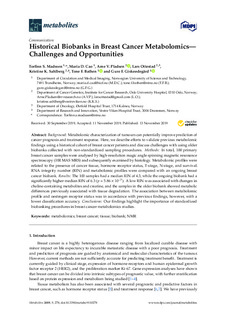| dc.contributor.author | Madssen, Torfinn Støve | |
| dc.contributor.author | Cao, Maria Dung | |
| dc.contributor.author | Pladsen, Arne Valebjørg | |
| dc.contributor.author | Ottestad, Lars | |
| dc.contributor.author | Sahlberg, Kristine Kleivi | |
| dc.contributor.author | Bathen, Tone Frost | |
| dc.contributor.author | Giskeødegård, Guro F. | |
| dc.date.accessioned | 2019-12-19T06:58:16Z | |
| dc.date.available | 2019-12-19T06:58:16Z | |
| dc.date.created | 2019-12-04T15:03:18Z | |
| dc.date.issued | 2019 | |
| dc.identifier.citation | Metabolites. 2019, 9 (11) | nb_NO |
| dc.identifier.issn | 2218-1989 | |
| dc.identifier.uri | http://hdl.handle.net/11250/2634059 | |
| dc.description.abstract | Background: Metabolomic characterization of tumours can potentially improve prediction of cancer prognosis and treatment response. Here, we describe efforts to validate previous metabolomic findings using a historical cohort of breast cancer patients and discuss challenges with using older biobanks collected with non-standardized sampling procedures. Methods: In total, 100 primary breast cancer samples were analysed by high-resolution magic angle spinning magnetic resonance spectroscopy (HR MAS MRS) and subsequently examined by histology. Metabolomic profiles were related to the presence of cancer tissue, hormone receptor status, T-stage, N-stage, and survival. RNA integrity number (RIN) and metabolomic profiles were compared with an ongoing breast cancer biobank. Results: The 100 samples had a median RIN of 4.3, while the ongoing biobank had a significantly higher median RIN of 6.3 (p = 5.86 × 10−7). A low RIN was associated with changes in choline-containing metabolites and creatine, and the samples in the older biobank showed metabolic differences previously associated with tissue degradation. The association between metabolomic profile and oestrogen receptor status was in accordance with previous findings, however, with a lower classification accuracy. Conclusions: Our findings highlight the importance of standardized biobanking procedures in breast cancer metabolomics studies. | nb_NO |
| dc.language.iso | eng | nb_NO |
| dc.publisher | MDPI | nb_NO |
| dc.relation.uri | https://www.mdpi.com/2218-1989/9/11/278 | |
| dc.rights | Navngivelse 4.0 Internasjonal | * |
| dc.rights.uri | http://creativecommons.org/licenses/by/4.0/deed.no | * |
| dc.title | Historical Biobanks in Breast Cancer Metabolomics — Challenges and Opportunities | nb_NO |
| dc.type | Journal article | nb_NO |
| dc.type | Peer reviewed | nb_NO |
| dc.description.version | publishedVersion | nb_NO |
| dc.source.volume | 9 | nb_NO |
| dc.source.journal | Metabolites | nb_NO |
| dc.source.issue | 11 | nb_NO |
| dc.identifier.doi | https://doi.org/10.3390/metabo9110278 | |
| dc.identifier.cristin | 1756711 | |
| dc.description.localcode | © 2019 by the authors. Licensee MDPI, Basel, Switzerland. This article is an open access article distributed under the terms and conditions of the Creative Commons Attribution (CC BY-) license (http://creativecommons.org/licenses/by/4.0/). | nb_NO |
| cristin.unitcode | 194,65,25,0 | |
| cristin.unitname | Institutt for sirkulasjon og bildediagnostikk | |
| cristin.ispublished | true | |
| cristin.fulltext | original | |
| cristin.qualitycode | 1 | |

